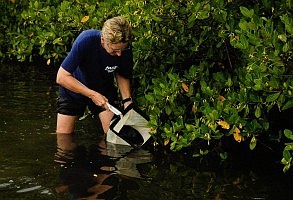- April 22, 2024
-
-
Loading

Loading

Scientists with the Mote Marine Laboratory and Florida’s Fish and Wildlife Conservation Commission released hatchery-reared juvenile common snook, a species of marine fish also known as Sergeant fish, into the wild Aug. 15 as a part of an ongoing program designed to find the most effective methods to replenish and enhance wild snook populations.
The species is one of Florida’s most popular sport fish and plays an important role in drawing recreational anglers to the state. According to the American Sportfishing Association, Florida is the top-ranked state in economic output from recreational fishing, which draws $8.6 billion to the economy annually. Saltwater fishing alone generates 80 percent — $6.8 billion — of that income.
Snook, along with red drum, are the main test species for restocking efforts statewide. This project involves tagging and then releasing more than 2,200 snook into Sarasota Bay during over three days, and is designed to determine whether snook have been conditioned for release at Mote have better growth and survival rates in the wild.
This event is an example of Mote’s ongoing efforts to develop and support public-private partnerships for the conservation and sustainable use of our marine resources. The snook release was funded by a private donation to Mote, and from funding provided by FWC.
For over 25 years, Mote and FWC scientists have partnered on studies designed to increase the effectiveness of stock enhancement in Florida.
Past Mote and FWC research conducted through pilot snook releases took place between 1997 and 2006, have shown that hatchery-reared fish released into the wild can indeed contribute to the local fishery with the fish growing to adulthood.
Tag data recovered after these small-scale pilot release experiments showed that Mote and FWC were able to improve the survival rate of stocked fish by more than 200 percent.
“We’ve found over time that we can improve the survival of hatchery snook released into the wild by 10 times just by choosing the right habitat,” Dr. Kenneth Leber, Associate Vice President for Mote’s Directorate for Fisheries and Aquaculture, said. “We also know that there are limits on how many fish you can put in each habitat before you start to lose hatchery snook. These pilot studies we’re doing now are further defining the best methods for snook stock enhancement.”